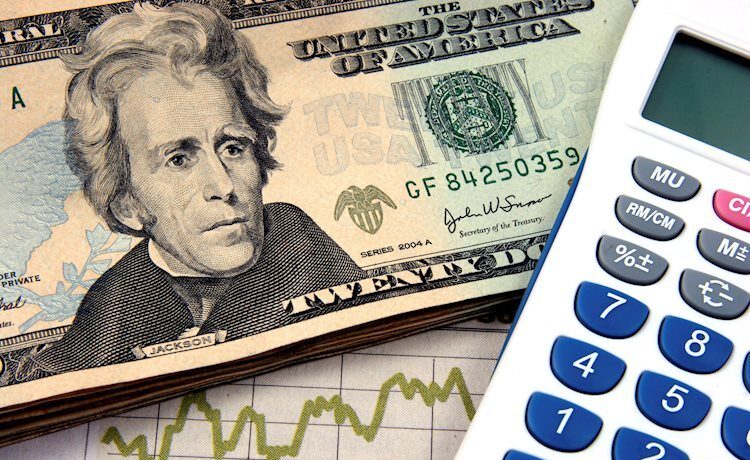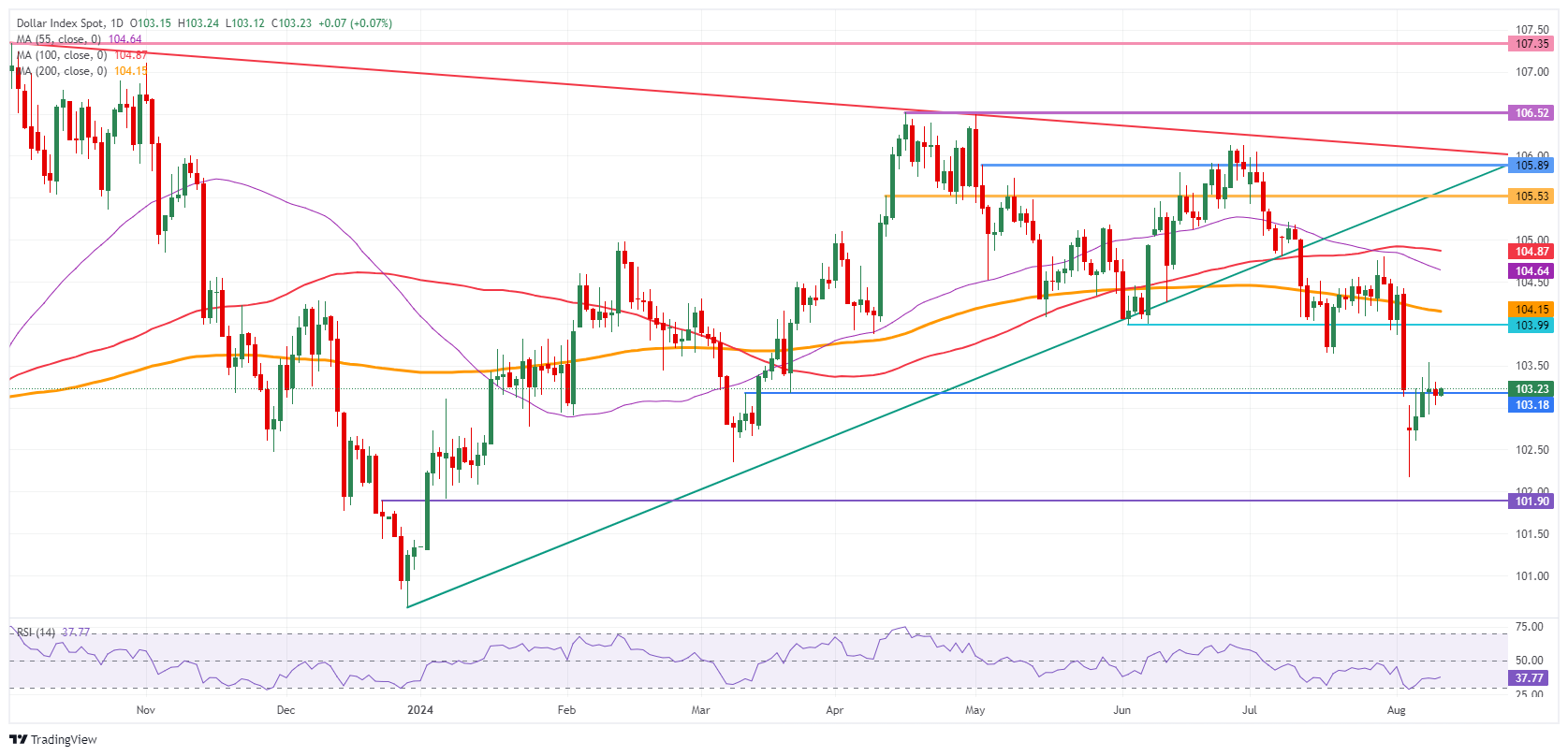- The US Dollar is flat to marginally gaining against most major peers.
- All eyes are on the US inflation print for July being released on Wednesday.
- The US Dollar index resides near a key level, and a substantial move could be seen later this week.
The US Dollar (USD) has a soft opening this week, with no real outliers on the quote board on Monday. Traders are taking a clean sheet and have deemed last week’s events as water under the bridge. All eyes will be on the US Consumer Price Index (CPI) for July, which is scheduled for Wednesday.
On the economic data front, it is a calm start to the week, with the US Treasury heading back to markets to auction some shorter-term bills. As such, it is nothing special, though with yields having moved quite a lot last week, traders and markets will be cautious if the bond market hits that snapping point when prices could collapse again. Besides the US CPI, the US Retail Sales data for July scheduled for Thursday will be the last important data point this week.
Daily digest market movers: US Treasury heading to markets
- Although the week has started very calmly, the US Dollar is stronger by 0.5% against the Korean Won (KRW) and the Japanese Yen (JPY) in early European trading.
- Bloomberg reports that in a column on Friday, the People’s Bank of China (PBoC) reported that the PBoC will keep a close eye on the potential rate cuts from the US Federal Reserve (Fed) and will act accordingly to keep the Yuan (CNY) stable against the US Dollar (USD). That could mean substantial devaluations for the CNY once the US Dollar devalues on the back of interest rate cuts from the Fed in order to catch up on the move.
- At 15:30 GMT, the US Treasury will allocate a 3-month and a 6-month bill.
- The US Monthly Budget Statement for July is expected at 18:00 GMT. Expectations are for a deficit of $254.3 billion, coming from a $66 billion deficit.
- Equity markets are going for a calm start to the week. Most major indices are in the green by less than 0.5%.
- The CME Fedwatch Tool shows a 53.5% chance of a 25 basis points (bps) interest rate cut by the Fed in September against a 46.5% chance for a 50 bps. Another 25 bps cut (if September is a 25 bps cut) is expected in November by 42.1%, while a 48.0% chance for a 50 bps cut and 9.9% for a triple rate cut are being pencilled in for that meeting.
- The US 10-year benchmark rate trades at 3.93% after popping above 4.00% briefly on Thursday.
US Dollar Index Technical Analysis: Steady start of the week
The US Dollar Index (DXY) is still trading at that key level since last week, when itwas unable to close above it and continue its recovery. Everything will now depend on the inflation report on Wednesday to move the needle forward. Either the report is disinflationary, and the US Dollar eases further, or there is a pickup in inflation and September starts to look doubtful for an initial interest rate cut.
Still, the first level to recover, which gains importance every day, is 103.18, a level held on August 2 though snapped on August 5 in the Asian hours. Once the DXY closes above that level, next up is 104.00, which was the support from June. If the DXY can return above that level, the 200-day Simple Moving Average (SMA) at 104.15 is the next resistance to look out for.
On the downside, the oversold condition in the Relative Strength Index (RSI) indicator has eased in the daily chart and holds room again for a small leg lower. Support nearby is the March 8 low at 102.35. Once through there, pressure will start to build on 102.00 as a big psychological figure before testing 101.90, which was a pivotal level in December 2023 and January 2024.
US Dollar Index: Daily Chart
Central banks FAQs
Central Banks have a key mandate which is making sure that there is price stability in a country or region. Economies are constantly facing inflation or deflation when prices for certain goods and services are fluctuating. Constant rising prices for the same goods means inflation, constant lowered prices for the same goods means deflation. It is the task of the central bank to keep the demand in line by tweaking its policy rate. For the biggest central banks like the US Federal Reserve (Fed), the European Central Bank (ECB) or the Bank of England (BoE), the mandate is to keep inflation close to 2%.
A central bank has one important tool at its disposal to get inflation higher or lower, and that is by tweaking its benchmark policy rate, commonly known as interest rate. On pre-communicated moments, the central bank will issue a statement with its policy rate and provide additional reasoning on why it is either remaining or changing (cutting or hiking) it. Local banks will adjust their savings and lending rates accordingly, which in turn will make it either harder or easier for people to earn on their savings or for companies to take out loans and make investments in their businesses. When the central bank hikes interest rates substantially, this is called monetary tightening. When it is cutting its benchmark rate, it is called monetary easing.
A central bank is often politically independent. Members of the central bank policy board are passing through a series of panels and hearings before being appointed to a policy board seat. Each member in that board often has a certain conviction on how the central bank should control inflation and the subsequent monetary policy. Members that want a very loose monetary policy, with low rates and cheap lending, to boost the economy substantially while being content to see inflation slightly above 2%, are called ‘doves’. Members that rather want to see higher rates to reward savings and want to keep a lit on inflation at all time are called ‘hawks’ and will not rest until inflation is at or just below 2%.
Normally, there is a chairman or president who leads each meeting, needs to create a consensus between the hawks or doves and has his or her final say when it would come down to a vote split to avoid a 50-50 tie on whether the current policy should be adjusted. The chairman will deliver speeches which often can be followed live, where the current monetary stance and outlook is being communicated. A central bank will try to push forward its monetary policy without triggering violent swings in rates, equities, or its currency. All members of the central bank will channel their stance toward the markets in advance of a policy meeting event. A few days before a policy meeting takes place until the new policy has been communicated, members are forbidden to talk publicly. This is called the blackout period.


















